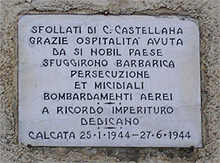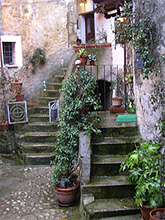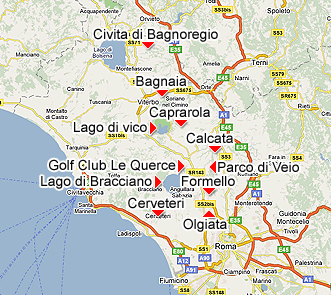Calcata, a Village of Artists North of Rome Alice
Twain, January 2006 Alice
Twain, January 2006Calcata is a small village in Lazio, north of Rome, near Sutri, Nepi and Civita Castellana, on the edge of the southern Maremma. When the early settlers came to the southern Maremma and faced this rough and densely wooded area, they split in two parties. The first group decided to live in the unhealthy lower valleys and become bandits. The second group moved up into the hills to build their villages far from the swamps and the bandits. Most of the ancient villages of this area are perched on top of the highest hills, while the lower areas have recent, modern villages, built after the drainage that made the Maremma a place where birds would not lose their feathers. Tutti mi dicon Maremma, Maremma... Ma a me mi pare una Maremma amara L'uccello che ci va perde la penna Io c'ho perduto una persona cara. Sia maledetta Maremma Maremma sia maledetta Maremma e chi l'ama Everybody says "Maremma, Maremma" It looks to me a bitter Maremma The bird that goes there loses the feathers I have lost there someone dear Maremma, Maremma may be cursed Be cursed Maremma and those who love it  Many
of the hills of the Maremma are impressive and craggy tufaceous
growths. These were the best locations for building towns and villages
because they provided safe, steep crests, cheap and abundant building
material and, usually, a good water supply. These hills were soon
topped with fortified, walled towns. This is where the rich lived,
leaving the lower areas to the poor. In the middle ages, the elites
adorned their villages with small palaces and churches as in the
towns of Sovana and Pitigliano, where the Aldobrandeschi and Orsini
families reigned (um, "earled") from the 11th to 17th
centuries. Many
of the hills of the Maremma are impressive and craggy tufaceous
growths. These were the best locations for building towns and villages
because they provided safe, steep crests, cheap and abundant building
material and, usually, a good water supply. These hills were soon
topped with fortified, walled towns. This is where the rich lived,
leaving the lower areas to the poor. In the middle ages, the elites
adorned their villages with small palaces and churches as in the
towns of Sovana and Pitigliano, where the Aldobrandeschi and Orsini
families reigned (um, "earled") from the 11th to 17th
centuries.These villages and towns declined after the 18th century. The late 20th century and the industrialization of Italy gave them the final shove; the inhabitants left them for the nearby cities and towns or built new, easier to access, villages at the foot of the hills. Pitigliano and nearby Sorano and Sovana are probably the most famous (as well as the best preserved and most impressive), but similar villages are scattered all over the southern Maremma area. Among them is Calcata in the Viterbo province. The area of Calcata has been inhabited since prehistory - certainly since the 8th to 7th century BC - but the current village was built by the Anguillara family in the 13th century. The slow decay of the stone causing the outer edges of the village to crumble, encouraged the first villagers to move to the new plain (in both senses of the word) village at the foot of the hill, yet in 1944 Calcata was still lively enough to host the refugees from the nearby town of Civita Castellana, who sought escape from the war and bombings. Displaced persons from C. Castellana Thanks for the hospitality received from such a noble town They flee barbaric persecution and deadly air raids They dedicate in eternal memory Calcata 1/25/1944 - 6/27/1944 Being impossible to even enter the village by car, by the 1960s the population had finally moved to the new village or to nearby Rome (just 40 kilometers south).This is when the old village returned to life. In the late 1960s and 1970s artists from all over Italy and the western world started to move to old Calcata, establishing a unique community. These new Calcatesi restored the ancient village where possible and turned it into a local attraction, a favorite for Sunday daytrips by Romans who go there searching for relaxation and contact with nature and culture. Yet this little jewel, despite its international population, remains quite unknown to many travelers. Calcata, in the region of Lazio, north of Rome Arriving in Calcata the first thing you will see is a thick curtain of houses that seem to be built in layers, one on top of the other. The only access to the village is a steep cobble stoned street straddled by a narrow gate, too narrow to allow cars through. Cars can be parked in the small lot in front and to the right of the gate. On Sundays there are many cars, sometimes parked all the way along the road leading to Calcata, so it's a better idea to visit the village on a weekday. Shortly after entering the gate the street levels out, although as you move from the central square you will hit stairs of varying degrees of steepness leading to the terraces on the sides of the hill and village. From these terraces you will be able to enjoy the view of the Treja valley on clear days.  On
the main square, the old parochial church hosted the most unusual
of the Christian relics: Jesus' foreskin, the only part of Jesus'
body left on earth (after all he was a Jew and therefore he had
been circumcised). This relic had originally been kept in Rome,
but it's said to have been stolen by a German soldier during the
occupation by the Charles V troops in 1527 and brought to Calcata
where he hid the relic until his death. Found by the local priest,
the relic has since been kept in the church. In the early 1970s
the relic disappeared once again, probably stolen, although some
say it has been hidden on request by the Vatican because it was
too embarrassing. On
the main square, the old parochial church hosted the most unusual
of the Christian relics: Jesus' foreskin, the only part of Jesus'
body left on earth (after all he was a Jew and therefore he had
been circumcised). This relic had originally been kept in Rome,
but it's said to have been stolen by a German soldier during the
occupation by the Charles V troops in 1527 and brought to Calcata
where he hid the relic until his death. Found by the local priest,
the relic has since been kept in the church. In the early 1970s
the relic disappeared once again, probably stolen, although some
say it has been hidden on request by the Vatican because it was
too embarrassing.All around the church, the meandering streets lead to houses that sometimes preserved their medieval looks and sometimes have been (badly) restored in the 1950s and 1960s. The buildings are heaped in a seemingly disarray and host numerous shops and workshops by the many artists and artisans that live in Calcata, as well as tea rooms and restaurants. The works of the artists can be seen at several exhibition centers throughout and outside the village. Artisanal shops sell furniture, modern and vintage macram and lace, knitted items, jewelry, antiquities, and other objects both produced locally or imported from Asia and South America. The village hosts several restaurants, ranging from traditional Roman and Maremmana cuisine to North African couscous to vegetarian foods. For a mid-afternoon break 201 Tea House offers a selection of 201 different teas (!!) and excellent pastries. Several bars and pubs offer drinks and, at night, live music. Calcata is also the seat of the Oshanti association, which organizes meditation meetings each Sunday afternoon. The vegetarian circle of Calcata (piazza Roma 23, Calcata) organizes collective meals and other activities. Finally, Louise Desmond McDermott's Italica Books deals old and out of print English books on Italy and can be contacted to receive her catalog as well as to fix an appointment to visit her business, which is located in private premises. Calcata can be visited on daytrip from Rome, but you may also decide to spend a couple of days staying in one of the four B&B and vacation rentals available in the village. Self-catering supplies, ATM and other services are available in the nearby villages of Calcata Nuova, Faleria and Mazzano. From Calcata, you can visit Lake Bracciano with its three villages of Bracciano, Anguillara Sabazia and Trevignano, explore the surrounding Valle del Treja Park, explore the Etruscan ruins in Narce, or do a trip to Rome. |
